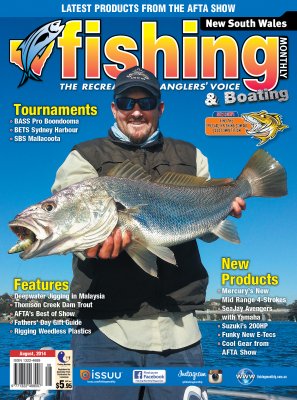Spring gold in the weed by Toby Grundy
 When spring rolls around I like to get out and catch a few big fish early on in the season. Getting a few quick points on the board is important because it helps build my confidence again after the leaner winter months.
When spring rolls around I like to get out and catch a few big fish early on in the season. Getting a few quick points on the board is important because it helps build my confidence again after the leaner winter months.
Golden perch are the perfect fish to chase when you're looking to tighten your game because they are a strong adversary on light gear, providing exciting runs and powerful head shakes. Bait fishing for these bars of gold in September and October is a great way to spend an afternoon on the water and will help hone your skills for the coming summer onslaught.
KNOW YOUR QUARRY
Golden perch (also known as yellowbelly or callop) are a powerful native fish which are closely related to Murray cod and display similar behaviours with their giant relation. Once they have matured, yellowbelly leave the school behind, set up residence in a large snag and ambush anything that has the nerve to pop its head in. Their eyesight is similar to humans and so a lure flicked past their nose will often get a response.
It is also important to note that golden perch have an incredible sense of smell. The large nostril openings (nares) near the eye are a dead giveaway. Because of this keen sense of smell, they respond well to bait. Using bait will bring the perch to you and, depending on where you are fishing, often in strong numbers.
WHERE AND WHEN
Springtime provides a wonderful opportunity to get outside and have a look around lakes and rivers for golden perch. After a good dump of rain near the end of winter it's important to go for a walk around likely areas to look for structure and, if you're an experienced angler, to look for changes to significant snags such as logs and rocks. The rising water levels and warmer weather will get the perch on the chew so it's important to have an idea of where they may be residing.
I don't baitfish for goldens in amongst the timber. I find these snags to be incredibly frustrating for two reasons: one being the constant re-rigging and the other being that if I do get a large fish, there is high chance that it will wrap my line on the first run.
Instead, when baitfishing for these wily natives in spring I focus on weed beds. I find that I can get a lot of fish by focusing on these areas and I don't get the same number of snags. Schooling perch can often hold quite deep but larger specimens will seek shallow water once they come of size. Therefore, a weed bed presents the perfect environment for them - shaded, shallow and full of food. Perch will often sit just outside or just inside the weed bed, depending on what kind of food they are looking for.
I recently took a group of fishos out at the start of spring who had struggled to catch a perch throughout summer and autumn. They were shocked when I parked myself beside a weed bed because there was no other discernible structure. After two yellas came into the net I left them (and their smiling faces) to it!
TECHNIQUE
When you find a likely weed bed, make sure you berley the area. I use a mix of chopped scrub worms, Ultrabite, yabby tails and bread. It is important to berley throughout the session so as to take advantage of the goldens' extraordinary sense of smell.